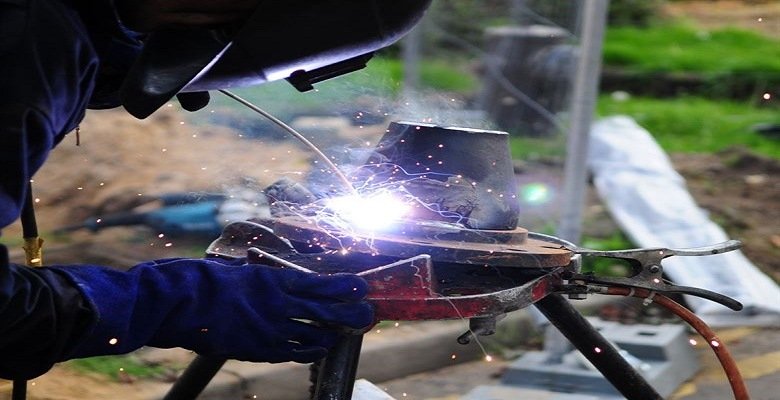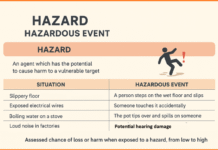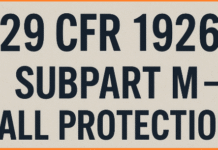Hazards associated with welding
- Radiation hazards
- Hazards due to dangerous fumes & gases
- Burns & eye injuries
- Fire & explosion hazards
- Environment/atmospheric conditions
- Electric shocks
- Postural fatigue
- Hazards associated with workings at height
- High noises level during certain operations
Light rays (ultra violate rays)
- Sunburn to eye surface which leads to pains & temporary disablement.
- Direct looking at rays without eye protection can cause permanents eye injury.
- Can cause sunburn to skin.
Infra –red rays - Heating the tissues with which it comes in contact.
Precautions:-
– Use proper shade welding glasses as per the intensity of the light.
– Use welding hand gloves for protection of hand skin from heat.
– Use hoods to cover neck & some portion of face.
– Apply light deflecting cream.
Electric shock:-
– The welding cannot be neglected as potential hazards though the open circuit voltage is not that high compared to other processes.
– Unless care is exercised the welder can easily become grounded.
– Operator can be exposed to the open voltage while setting up work, changing electrodes or changing work position especially in hot weather when he is sweaty.
Precaution:-
– Prevent contact of falling sparks with cables in confined places.
– Never change electrode with bare hands, wet gloves or standing on wet floors.
– Ground the frames of welding units as per I.S Use spectacles & plug which have been approved to break full load.
– Worn out work lead or electric leads expositing the bare conductors should be covered with the rubber, plastic or friction.
– Keep welding cable dry and free of grease and oil to prevent premature breakdown of the insulation.
– Take care to keep welding cables away from power supply cables or high tension cables.
– Never coil, loop welding cables around your body.
– Suspend cables on substantial overhead supports or lay in such a way that they don’t get damaged or entangled.
– No electrical apparatus exceeding 24 volts should be taken inside the confined space.
– All the cable should be protected from the heat and puncture.
– The job and the portable electrical equipments taken inside must be properly earthed.
– Ground the work piece separately from the welding return connection.
– Always insulate yourself using dry insulation. When welding in damp locations, on metal floors, gratings or scaffolds and particularly when in positions (such as sitting or lying) where large areas of your body can be in contact with the conductive surface.
– Maintain the electrode holder, work clamp, welding cable and welding machine in good condition.
– Never dip the electrode holder in water for cooling.
– When working above floor level, protect yourself from a fall should you get a shock. Never warp the electrode cable around any parts of your body.
– Use shield with proper filter glass and the cover glass to protect your eyes from sparks and the rays of the arc when welding or observing open arc welding.
– Use suitable clothing to protect your skin and that of your helpers from the arc rays.
– Protect other nearby personnel with suitable non-flammable screen and warm them not to watch the arc nor expose themselves to the arc rays or to hot spatter of metal.
– Droplets of molten slag and metal are thrown or fall from the welding arc. Protect yourself with oil-free protective wear such as leather gloves, coffles trousers, safety shoes. Wear ear plugs/ear muffs while welding out of position or in confined space.
– Always wear safety spectacles whenever you are in welding area. Use spectacles with side shield when near flag chipping operations.
– Remove fire hazards well away from area. If impossible, cover them to prevent the welding sparks from starting a fire. Sparks and hot materials from welding can go easily through small cracks and opening to adjacent.
– When not welding, make certain that no parts of the electrode circuit are touching work on ground. Accidental contact can cause overheating and create a fire hazard.
– Be sure that work cable is connected to the work as close to the welding area as practical. Work cable connected to the building framework or other locations some distance from the welding area increase the possibility of the welding current passing through the lifting chains, crane cables or other alternate circuits this can create fire hazards or overheat lifting chains or cables until they fail.
– Welding may produce fumes and gases hazardous to health. Avoid breathing these fumes and gases. When welding keep your head out of the fumes. Use enough ventilation and/or the arc to keep fumes and gases away from the breathing zone. When welding on galvanised, lead or cadmium plated steel and other metal that produce toxic fumes, use more caution.
– Do not weld locations near chlorinated hydrocarbon vapour are coming from degreasing cleaning, or spraying operations. The heat & rays of the arc can react with solvent vapours to from phosgene, a highly toxic gas and other irritating products.
– Do not heat, cut or weld tanks, drum or containers until the proper steps have been taken to ensure that such procedure will not cause ignition of flammable or release or toxic vapour from substances inside. They can cause an explosion even though they have been cleaned.
– Vent hollow casting or containers before heating, cutting or welding. They may explode.
– Have a qualified electrician for doing installation, troubleshooting & maintenance work.
– Be sure that the frames of the welding equipment and power source are grounded properly. The fixture and metal being welded must also be connected to a good electrical earthing. The power off before doing any maintenance work inside the welding equipment.
– Keep all covers & safety devices in position & good repairs.
– Keep hands, hair, clothing and tools away from moving parts when operating or repairing equipment.






ok ji
we have all kind of welding glasses
very helpful post
thanks for your article
Hello,
I read your article and it really interesting and beneficial for the electrician.
please give some suggestions about mig welding and what will be the best mig machine for the beginners